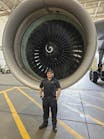The battle against carbon emissions continues to rage on with almost every vertical from farming to artificial intelligence working hard to find ways to boost sustainability – and the transportation space is no different. However, while automotive has been swept up by the EV revolution, the aviation space is still finding its feet in terms of how it is going to improve its performance reining in its carbon footprint.
Aviation is one of the most fuel intensive sectors around the world today – contributing 5% to human made global warming. Aviation teams are trying to find innovative ways – such as less emission intensive routing and environmentally friendly food service – but curbing emissions in aviation is proving to be one of the most challenging climate change related tasks the transportation industry has had to take on yet. This is why the aviation industry is leaving no stone unturned when it comes to studying every aspect of their aircraft and operations strategies.
With that in mind, here are several under the radar efforts that the aviation industry is taking to chip away at its emissions output.
Cooling
Beyond just propulsion, the cooling of aircraft cabins is a significant contributor to carbon emissions – particularly when planes are parked on the ramp or at the gate. And while aviation teams have gone to great lengths to find ways to optimize fuel use for these purposes, keeping parked aircraft at a comfortable temperature for workers and for passengers requires extensive use of ground and auxiliary power units, resulting in extensive CO2 emissions. To reduce this, aviation teams have begun to think of outside-the-box solutions to decrease cooling demands.
One of the biggest culprits of solar heat entering the aircraft are the aircraft window openings, and this is now being addressed. Much maligned for their relatively poor insulation properties, traditional windows have been reworked time and again by OEMs to the best of their abilities but to only minimal avail. However, with the dawn of nanotechnology, aviation OEMs are beginning to utilize suspended particle device (SPD) technology in their window openings. The technology is used in electronically dimmable windows (EDWs) – and has been proven to be far more effective in terms of thermal insulation – to dramatically reduce cooling needs particularly on parked aircraft, and thus substantially decrease the associated CO2 emissions.
Lightweighting
Another major emissions reduction boon for aviation OEMs is coming by way of lightweighting. For example, studies have shown that a 20% weight reduction can boost the fuel efficiency of a Boeing 787 by up to 12%. These types of numbers are hugely exciting for aviation OEMs and their airline customers alike, which is why OEMs are pouring money into their lightweighting efforts. This includes expanding use of already popular methods including aluminum and titanium alloys and heat resistant resins in addition to doing R&D on emerging materials such as graphene. Moreover, by reducing things like heating and cooling demands, OEMs are finding that they can downsize certain functional elements – like A/C compressor technology – which can also deliver unexpected lightweighting benefits.
All Eyes Turn to Electric Short Haul Aviation
The EV revolution has captured the imagination far beyond the automotive industry. While it is exciting to see the demand for electric vehicles hit all-time highs, wide scale adoption of commercial electric aviation is more likely to be seen in the mid- to long-term. That doesn’t mean that innovation and testing isn’t underway already with short haul and local electric aviation likely to become a reality in the coming years. In fact, the idea of electric vertical takeoff and landing aircraft (eVTOL) has become such a promising prospect that some of the world’s largest aviation brands have quietly placed orders for over 1,500 of these aircraft over the last two years alone. So, while little has been made of this space as of yet, and pilot programs are yet to begin in earnest, the short haul space is set to be one of the foremost innovation hubs for the aviation industry in the years to come.
Emissions have been one of the biggest thorns in the side of the aviation industry for decades. However, thanks to a new wave of technological innovation, and equally as ambitious goals within the aviation industry itself, the next 10 years could see the dawn of a new age of cleaner air travel.
Michael LaPointe became Research Frontiers' Director of Marketing for Architectural Windows and Displays in March 2000 and was promoted to the position of Vice President - Marketing in March 2002. Michael LaPointe, a graduate of Brown University with a B.A. in Organizational Behavior & Management and a B.A. in Psychology, worked in a marketing capacity for IBM Corporation in the early 1980s. He subsequently founded and developed several companies involved in the application and licensing of new technologies for various consumer products. During that period Mr. LaPointe also worked as a management consultant, where in 1994 he began his relationship with Research Frontiers, assisting it with its marketing strategy. He has extensive experience in licensing new technologies, both as a licensor and a licensee, and in bringing products using new technologies to market.






